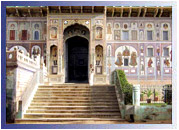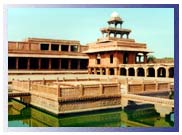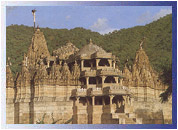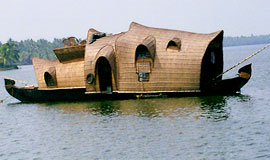MANDAWA (SHEKHAWATI) - THE OPEN - AIR ART GALLERY
The semidesert region of Shekhawati is colourful fantasy having a fascination
uniquely of its own. "The

open
air art gallery", as it is popularly called, is famous for its plethora
of painted havelis, all commendable pieces of the rich artistic tradition
of this region. 'Shekhawati' meaning "the land of Shekha's clan"
derives its name from Roa Shekha (1433 AD - 1488 AD) a scion of Kachhwaha
family of Jaipur. Earlier a part of the former Jaipur state. Intitailly the
region had a blank monochoromatic look but with subsequent historical and
social developments it has blossomed into colourful profusion of art and life
for almost2 centuries from 1750 AD to 1930 AD.
Besides the centaphs, wells, forts and temples, the Majority of frescoes are
painted on the havelis. This magnificent havelis or mansions, built by rich
merchants of the region, display a unique residentail architectural style
that evolved around the courtyards to ensure safety and privacy of the women
folk and protection from the heat of the long and harsh summers. The havelis,
painted predominantly in blue, maroon, yellow, green and indigo have beautiful
wall paintings that adorn their walls. The earlier wall paintings (1830 AD
-1930 AD) were largely based on trhe mythological themes, depicting local
legends, animals, portraits, hunting and wrestling scenes and a glimpse of
everyday life.
The are of Shekawati covers several villages and towns in north eastern Rajasthan
and comprises the Sikar, Jhunjhunu and Churu districts, small towns dot these
three districts and contain within themseleves some of the most elabotare
havelis, stepwells and temples.
SIKAR : Founded in the late 17 th centuary, Sikar was the largest
"Thikana (Feudal state) under Jaipur. The fort and temples of Goipinath,
Raghunath and Madan Mohan with commenadble Frescoes are worth visiting. The
Jubilee Hall, Madho Niwas Kothi, Bhiwani Haveli, Sodhan Haveli, The Jain temple.
Place to Visit
Harsh Nath Temple
An acient 10th century temple situated on the Harsh nath hills.
Jeena Mata Temple
Believed to have been built a thousand years ago, the temple is the venue
of colourful fair held twice in a year during Navaratras.
Lachhmangarh
One of the most imposing forts in the Shekhawati region, Lachhmangarh commands's
bird's eye view of the town modelled to resemble the city plan of Jaipur.
Founded in the early 19 th century by Raja Lachman Singh of Sikar, the town
has some lovely havelis.
Ramgarh
Founded in the late 18 th century by Poddars. The Shani temple of the saturday
god has delicately painted frescoes. Marvellous cenotaphs of the Poddars have
exquistely painted ceilings. The Ganga temple and some beautiful havelis.
Fatehpur
Founded in the mid 15 th century by Fateh Khan- a Kayamkhani nawab, the town
is noted for unmatched frescoes. its central locations attracted many wealthy
merchants and has some exquisite havelis - the combination of the Indian and
western styles. Chaamariya and Singhania havelis are main atraction.
JHUNJHUNU : The capital of Shekhawati,
its is one of the largest towns of the district. The district town has some
splendidly painted havelis. Easily accessible of these are those of Narsingh
Das Tibriwal, Ishwar Das, Mohan Das Modi, and the Khaitans. The most Interesting
monument is the Khatri Mahal (The Wind Palace) dating back around 1760 AD
with elegant lines. The Sri Bihariji temple is noted for its lovely murals.
Other places to see are Badalgarh, Jorawargarh, Ajit sagar and Jain temples.
Place to Visit
Mandawa
One of the finest of the small towns in the shekhawati region this feudal
settlement not only has a Royal castle, but innumarable havelis where the
painted facades offer a great variety of surprises. Mandawa was founded in
the 18 th century by Thakur Nawal singh,a descendant of Roa Shekha. The Medieval
fort dominates the town with a painted arched gateway adorned with Lord Krishna
and his cows. The Chokhani and Ladia havelis and the street with saraf havelis
are some of the splendid examples of this region's havelis. A Shiva temple
with a rock crystal lingam is also worth to see.
Mukandgarh
Founded in mid 18 th century by raja Mukand Singhnown for its fine havelis
and Massive fort now converted into ythe heritage hotel.
Dundlod
One of the pricipal feudal pricipalities of Shekhawati, Konwn for its Fort
and the havelis of his charming town are beautifully painted and some of them
are over two hundred years old, Goenka Haveli is well known for the exquisite
quality of its frescoes. Dera Dundlod Fort with saddles as bar stools . Polo
sticks and trophies strewn around. fort is fine example of mughal architecture.
Nawalgarh
Founded in 18 th century, The seat of poddar families. It has finest of Shekhawati
Frescoes. its two old forts and Roop Niwas Palace with garden and fountain
alongwith a host temples known for their architecture and frescoes. The promiment
havelis are of the poddars, Bhagats and Dangaichs.
Baggar
This Shekhawati ton is known for its late style frescoes. This town is home
of the Rungtas, Baggar was founded by Nagar pathans in the mid 15 thh century.
Piramal haveli built early years of this century is fine example of europeon
influences.
Chirawa
This town is famous for huge havelis of nand Lal Dalmia, Mangal Chand Dalmia,
phool chand Dalmia, Tara Chand dalmia, Duli Chand Kakrania and Nemains.
Pilani
The home of the Birlas, the leading industrials of India. it has a large campus
of Birla institute of technology and science. Pachwati and birla haveli museum
are main attraction of town.
Alsisar and Malsisar
Founded in the late and mid 18 th centuries respectively, these towns lie
at northern edge of Shkehawati. The angular style of frescoes in various colours
make the trip to these towns a memorable. Besides the fort in Alsisar, the
jhunjunuwala havelis and well complex are other interesting structures. The
fort, temples and havelis are worth visit.
Bissau
Founded in the mid 18 th century, Bissau has splendid Centaphs of Thakurs
and finely painted havelis of Khemka, tiberwala and khedia.
Mehansar
Founded in the mid 18 th century, known for the fine quality of its paintings,
it also has its richest horde of wall paintingd. The sone Chandi Ki haveli
and Raghunath temple with beautiful paintings resenblong the Bikaner school
of art.
CHURU : This the third district
of Shekhawati region, famous for the Kothar Haveli, Kanhayya Lal Bagla Haveli
having immense paintings of Dhola Maru, Sassi - Pannu etc. and the six storeyed
Surana Haveli. The distinctive features of the latter one are its beautiful
windows, elegant doors - more than 1,100 in number.
Place to Visit
Ratangarh
The massive fort built in 1820 by Raja of Bikaner -Ratan Singh. An array of
stately havelis can be sen around the clock tower.
Salasar Balaji
A famous temple dedicated to Monkey god Lord Hanuman Ji.
Sardar Shahar
This enchanting desert town has elegant havelis adorned with colourful wall
paintings and carved workwood.
Tal Chhapar
Home to the endangered species of black buck and some migratory birds.
::
Click
here for Reservation

Renowned
for some marvellously carved Jain temples in amber stone ranakpur is one of
the five holy places of Jain community. These temples were created in 15th
century during reign of rana Kumbha and are enclosed within a wall. The central
'Chaumukha' or four faced temple is dedicated to the venerated Tirthankaras
Risbahji. Open on all four sides, it enshrines the four faced image of Adinath.
Sparwling over 48,000 sq feet, the temple is an astounding creation three
storied structure, with 29 halls, 80 domes and 1,444 pillars and no two pillars
are alike every pillar is intricately carved with equal delicacy in Amber
stone. Images of 24 tirthankaras are carved on the mandaps or porticos in
a corridor around the shrine with each mandap having a shikhar or spire adorne
with little bells on the top. The gentle breeze wafting through the corridors
move the bells creating celestail music all around the complex. rising in
three storeys, the temple has four small shrines with 80 spires supported
by 420 columns.
::
Click
here for Reservation

 open
air art gallery", as it is popularly called, is famous for its plethora
of painted havelis, all commendable pieces of the rich artistic tradition
of this region. 'Shekhawati' meaning "the land of Shekha's clan"
derives its name from Roa Shekha (1433 AD - 1488 AD) a scion of Kachhwaha
family of Jaipur. Earlier a part of the former Jaipur state. Intitailly the
region had a blank monochoromatic look but with subsequent historical and
social developments it has blossomed into colourful profusion of art and life
for almost2 centuries from 1750 AD to 1930 AD.
open
air art gallery", as it is popularly called, is famous for its plethora
of painted havelis, all commendable pieces of the rich artistic tradition
of this region. 'Shekhawati' meaning "the land of Shekha's clan"
derives its name from Roa Shekha (1433 AD - 1488 AD) a scion of Kachhwaha
family of Jaipur. Earlier a part of the former Jaipur state. Intitailly the
region had a blank monochoromatic look but with subsequent historical and
social developments it has blossomed into colourful profusion of art and life
for almost2 centuries from 1750 AD to 1930 AD. 
 Renowned
for some marvellously carved Jain temples in amber stone ranakpur is one of
the five holy places of Jain community. These temples were created in 15th
century during reign of rana Kumbha and are enclosed within a wall. The central
'Chaumukha' or four faced temple is dedicated to the venerated Tirthankaras
Risbahji. Open on all four sides, it enshrines the four faced image of Adinath.
Sparwling over 48,000 sq feet, the temple is an astounding creation three
storied structure, with 29 halls, 80 domes and 1,444 pillars and no two pillars
are alike every pillar is intricately carved with equal delicacy in Amber
stone. Images of 24 tirthankaras are carved on the mandaps or porticos in
a corridor around the shrine with each mandap having a shikhar or spire adorne
with little bells on the top. The gentle breeze wafting through the corridors
move the bells creating celestail music all around the complex. rising in
three storeys, the temple has four small shrines with 80 spires supported
by 420 columns.
Renowned
for some marvellously carved Jain temples in amber stone ranakpur is one of
the five holy places of Jain community. These temples were created in 15th
century during reign of rana Kumbha and are enclosed within a wall. The central
'Chaumukha' or four faced temple is dedicated to the venerated Tirthankaras
Risbahji. Open on all four sides, it enshrines the four faced image of Adinath.
Sparwling over 48,000 sq feet, the temple is an astounding creation three
storied structure, with 29 halls, 80 domes and 1,444 pillars and no two pillars
are alike every pillar is intricately carved with equal delicacy in Amber
stone. Images of 24 tirthankaras are carved on the mandaps or porticos in
a corridor around the shrine with each mandap having a shikhar or spire adorne
with little bells on the top. The gentle breeze wafting through the corridors
move the bells creating celestail music all around the complex. rising in
three storeys, the temple has four small shrines with 80 spires supported
by 420 columns.